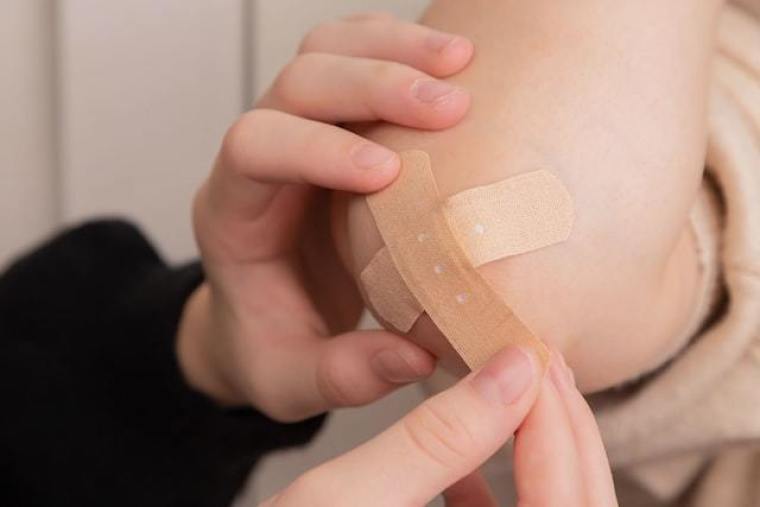
I enjoyed watching an old show called Tattoo Nightmares. The show based around an ink parlour that would help save people’s tattoos who had been ill-inked or the result of a poor decision. The artists on the show meet the guests, get to know their story, then come up with a design to cover up the bad ink.
I was always impressed with the way a bad tattoo could be covered up or incorporated into a new design. The results are amazing.
Some special occasions were guests who had birthmarks or surgery scars that are then incorporated into a tattoo design. These I found most enthralling. For some this was turning a catastrophic event (surgery or major injury) into something to be celebrated, with design and colour. What many were ashamed of or used to hide, now became a talking point.
Scabs or scars.
It reminds me of advice I once heard that our stories are either Scabs or Scars. There is a difference between both.
As we journey through life we accumulate stories. War-time stories, celebration stories, and the range in between. Sometimes some of these stories include battles, we might be wounded, or have wounded others, and these stories can take time to heal.
All wounds leave a mark. Physiologically speaking when we encounter an injury, our blood rushes to the site and platelets start to block the bloodflow. These platelets cause a scab to clog the wound site and other elements of our blood rush in to help repair the wound.
As time passes by the scab heals over and is replaced by a scar. In some cases this scar disappears. In other cases for deep wounds this may stay with a person for their life, sometimes growing with them as they do. In any case, the presence of a scar shows evidence of a wound, and generally holds a story to tell.
Scars for most people don’t hurt. They represent damage incurred in the past, but once healed, become a talking point and story about the wound. For some, they may want to cover up their scar, for others these turn these into talking points. In any case scars differ to scabs.
Scabs, during the healing process, need time to heal. Some scabs are covered, and under the protection of bandages, heal themselves. Others, if not treated properly can become infected. These infected scabs turn ‘angry’ looking, red, inflamed, itchy and raised. Some develop puss and ooze everywhere. If scabs aren’t properly cared for, or constantly touched and scratched at, they are never given the chance to heal.
Scars in Life
So it is with our lives. Wounds in life are inevitable. We can stay out of harms way, do our best to remain at peace with everyone, but in the nature of the world, interacting with people, doing life, impacts and injuries in life occur. How we react to these injuries I believe will determine whether we end up with a long-term scab or scar.
Walking around with an injury requires some care, as I said earlier, most scabs require a bandage, some covering to help time heal the wound. Wounds, when left out in the open or exposed to elements may not heal as well.
In life I am sure you have met people you can recall who seem to be living in the ‘scab’ of a past trauma. Each time you talk to them about a certain ‘wound’ it seems they are opening up the scab again, delving deep into the space and bringing up all the hurt associated with the wound.
Others, may be able to talk about the same incident, but, having had time to heal and the right tools at hand, can talk about the incident with a historical perspective. Talking about it from a place of healing, not hurt. There are others yet who might present as angry, dismissive or spew all over you when talking about trauma or injury, it seems these people are living with infected scabs of the past. The perspective between living with a scab or a scar is huge.
Looking for answers as to how can we move from scabs to scars, I’m not sure there is a magic answer, but I do think the following advice I have heard is worth noting:
Forgiveness
Jesus encourages us to forgive “seven times seventy” (Matthew 18:22). Or in other words, a lot of times. Not just for those who forgive us, but for anyone who does wrong against us. Forgiveness helps heal the heart, and the wounds of life which scar.
Covering
It is important when treating a wound to allow the healing process to occur. This is usually helped my covering wounds. In life covering, or protection may look like only speaking with certain people who can help in the journey of recovery, not opening up fresh wounds for the world to have input into.
This may be seen most publicily in the life of Hollywood stars. When something horrible happens in their life, they often retreat, disappearing from the face of public profile, until such a time has passed they can discuss their hurt and healing. As we process life, there will be certain people who can help in our healing journey, and other who may just help infect the wounds with words of gossip and judgement.
It is important to allow ourselves time to heal.
Stop picking
“Stop picking!” Is a term you may have heard parents tell children about a bite mark, or scratch. The same is true for our lives. Wounds left alone to heal may not even scar, whilst wounds and scabs that are constantly scratched have a much higher chance of taking longer to heal. Scratching at wounds opens up the wound and has the potential to introduce infection. Constant scratching can also result in a larger scar. In life, taking time to allow the process of healing is important, and once a scar is a scar, allowing it to be a scar and not pick at it again.
From scabs to scars, physically and in life, they tell a story. There is a difference between the two. It is important to allow time to heal under the privacy of covering and through the process of forgiveness.

Kelly Thompson is the newest member of the Sports journalist team. Kelly currently plays AFL for Casey Demons in the VFLW, and practices what she preaches as a HOPE (Health, Outdoor, and Physical Education) Teacher in Melbourne’s southeast.